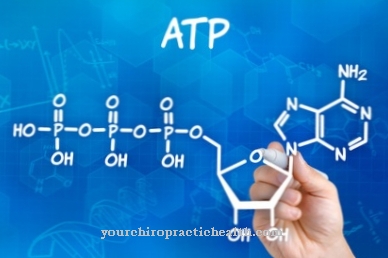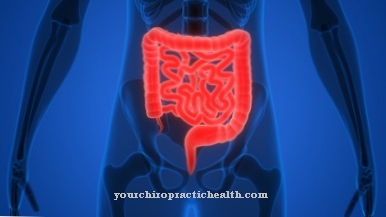The Proprioception is a complex interoception that informs the brain about the condition and movement of joints, tendons and muscles. Impaired proprioception can be caused by medication and drugs as well as neurological diseases and trauma.
What is proprioception?

The anatomical sensory structures are called the perceptual apparatus. In most cases, perceptions are external stimuli that are picked up by the stimulus-specific organ by means of specialized receptors and converted into bioelectrical excitation. After processing, they are projected into the central nervous system via afferent pathways. Only after the classification processes and interpretations of the central nervous system do perceptions pass into consciousness. This principle of receiving stimuli from outside gives an organism a picture of its surroundings and is known as exteroception.
The perception can also refer to a stimulus pickup from within. If the stimuli received come from within and thus enable self-perception, we speak of interoception.
Two structures of perception shape interoreception: visceroception and proprioception. Visceroception corresponds to the perception of organ activities. Propriorepzion, on the other hand, is the perception of one's own body position and movement in space. This type of self-awareness is also known as depth sensitivity and is divided into the sense of position (sense of position), the sense of movement and the sense of strength (sense of resistance). The most important receptors for these perceptions are the muscle spindle, the tendon spindle and the sensitive receptors of the joint capsule, ligaments and periosteum.
Function & task
Proprioception is made possible by deep sensitivity and the vestibular organ. Surface sensitivities play a minor role. The vestibular organ of the inner ear is the human organ of equilibrium, which can perceive linear and angular acceleration via sensory cells on so-called statoliths. Rotational movements are perceived by a fluid in the tube system of the inner ear as inertial mass.
The deep sensitivity, on the other hand, is located in the muscle tissue. Its receptors are the muscle spindle, the tendon spindle and the sensitive receptors of the joints, bones and ligaments. Proprioceptive stimuli are conveyed via the organelles of the proprioceptors and the interoceptors. These are mostly mechanoreceptors. They detect mechanical stimuli and thus correspond to sensitive end organs that respond to a state or a change in state in the holding and musculoskeletal system.
Via proprioception, humans perceive both the current state and changes in the state of their own body. The sense of position serves to sense the current starting positions. The sense of movement gives continuous feedback on the extent of one's own movement and continuously determines the body position during movement. The sense of force or resistance is used to dose and mediate between pull and pressure, as is required for every movement.
The proprioceptive nerve tracts lie in the sensory cortex. The main field of this structure is its posterior central turn, where fibers of the trigeminal nerve and the ascending posterior cord tracts intersect. In its somatotopic structure, the close proximity of this structure corresponds to the spinal cord. When sensitive areas of the body are stimulated, the central nervous system automatically keeps the motor areas and thalamic nuclei of the structures in readiness. This makes it easier for the human body to provide purposefully reactive movements. Some afferent pathways to the precentral gyrus probably also serve for proprioceptive processing.
Above all, deep sensitivity is an essential requirement for regulated motor skills and comes from the cerebellum (cerebellum). Some proprioceptive fibers originate from bones, visceral organs or vessels and first reach the hypothalamus. In the hypothalamus they are coupled with the impulses of the hormonal system and are thus involved in the regulation of vegetative and animal body functions.
The information from the proprioreceptors reaches the brain via two different pathways. The information from the conscious depth sensitivity reaches the somatosensory pathway of the thalamus and the parietal lobe in the cortex (cerebral cortex). Unconscious information from depth perception, on the other hand, migrates via the spinocerebellar tract into the cerebellum and thus reaches the center for movement control.
Proprioception differs from person to person in its characteristics. So there is no general proprioception, only a specific one.
You can find your medication here
➔ Medicines against memory disorders and forgetfulnessIllnesses & ailments
A foot that is asleep momentarily suppresses proprioception in the lower limb. This phenomenon is an everyday phenomenon that is usually preceded by misalignments or entrapment. In most cases the phenomenon has no direct pathological value. Sometimes, however, in extreme and chronic forms, it indicates diseases of the central nervous system, such as multiple sclerosis.
Proprioception in the sense of deep sensitivity also shows reactions to various medications, drugs and alcohol. For example, even the simplest movements suddenly become difficult for a drunk. The self-perception is crooked and causes a variety of posture problems, mobility disorders and coordination problems.
A disturbance of the proprioception can thus be caused by disturbances of the equilibrium organ as well as those of the muscle spindle or tendon spindle and bone receptors. Lesions of the mediating nerve tracts can also disable proprioception. Such neural lesions can have autoimmunological causes and can be caused by inflammation, as is the case with multiple sclerosis. However, they can just as easily be traced back to accidents and thus trauma. Further possibilities are masses or hemorrhages in the nerve areas involved or the responsible brain regions.
The cause of a disturbed or canceled proprioception is determined by means of imaging procedures. For example, an MRI can ideally determine the location of a given lesion.
Both the hypothalamus and the cerebellum or the respective afferent tracts can be the site of damage in the case of impaired proprioception. Sometimes problems with deep sensitivity also lie in the inner ear, because if proprioception can no longer access correct information from the vestibular organ, it no longer functions properly either.
























.jpg)



